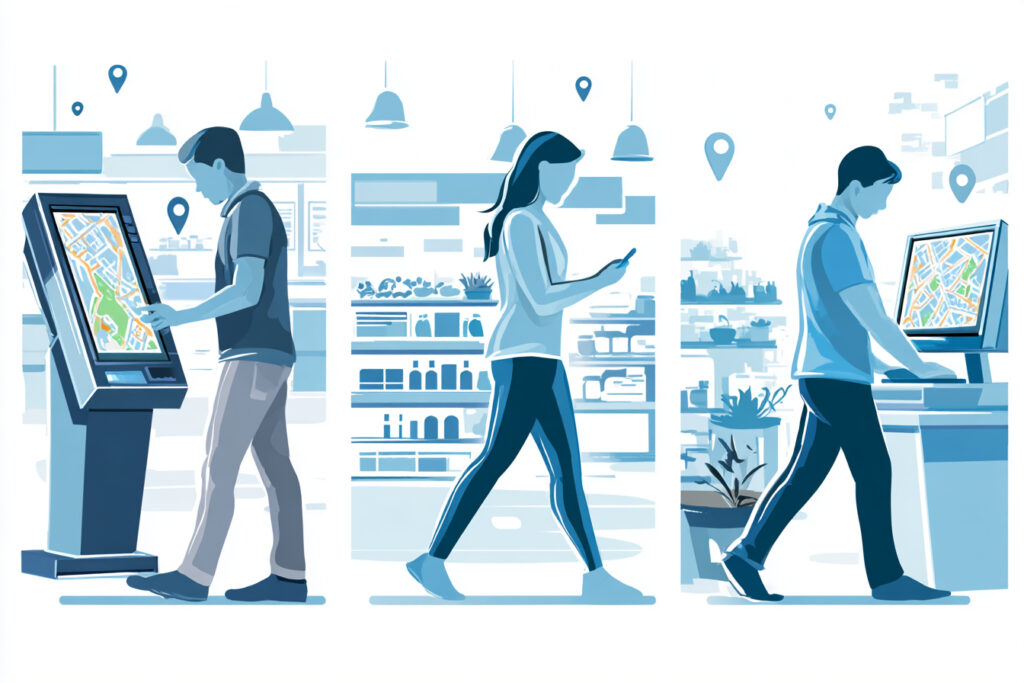Shoppers no longer compare malls to other malls. They compare them to the seamlessness of Amazon, Uber, and Google Maps. If your mall’s navigation feels clunky or disconnected, visitors disengage. And in 2025, disengagement translates directly into lost revenue.
This is where mall map software becomes more than a wayfinding tool. It’s an omnichannel system that drives measurable ROI through marketing, analytics, and customer experience — provided you choose the right platform.
Why Generic Mall Maps Fall Short
Most shopping centers already have some form of digital map, but many still rely on one-size-fits-all solutions. These templates may check the box for wayfinding but rarely deliver on revenue impact. Common gaps include:
- Limited customization — can’t reflect your brand or unique tenant mix
- Static updates — store changes, events, and promos don’t sync in real time
- No marketing value — maps function as a cost center, not a revenue channel
- Lack of analytics — no visibility into what shoppers search, where they dwell, or which promotions convert
The result is a tool that informs but doesn’t influence. It guides a shopper to a restroom but can’t nudge them toward a flash sale or track whether a campaign drove foot traffic.
The Omnichannel Advantage in 2025
Today’s mall map software has to operate across multiple touchpoints — kiosks, mobile, web, even AI assistants. Omnichannel deployment ensures shoppers engage wherever they are:
- At the entrance: Interactive kiosks provide instant orientation
- On the move: QR codes let visitors take their route on mobile
- At home: Web maps help shoppers plan visits in advance
- In conversation: AI assistants answer natural-language queries like “Where’s the nearest shoe store?”
A map that lives on multiple platforms increases engagement time and conversion opportunities. It also captures more data points, fueling insights into shopper behavior.
From Navigation to Marketing Engine
In 2025, mall map software should act as a marketing platform just as much as a navigation tool. The most advanced systems enable:
- On-map advertising — retailers promote their store directly on the map interface
- Geofenced push notifications — alerts triggered when shoppers enter specific zones
- Targeted promotions — sponsored listings that appear in search results
- Event integration — maps that update dynamically for concerts, pop-ups, or seasonal markets
These features create new revenue streams for malls and give tenants measurable ROI for marketing spend.
Analytics: The Real ROI Driver
The difference between a cost and an investment is measurement. With analytics baked into mall map software, managers can:
- Track foot traffic and dwell times by zone
- See which stores or products are most searched
- Identify underperforming areas that need revitalization
- Provide tenants with hard data to justify leasing costs or marketing fees
Analytics transform mall maps into growth engines, enabling operators to align promotions with real-time demand and prove ROI on events and campaigns.
Case in Point: Tailored vs. Template
At MapVX, we’ve seen the difference firsthand. In Bogotá, the Andino Shopping Center deployed an interactive map system that went beyond basic navigation. With real-time analytics and targeted promotions, the center boosted both tenant sales and shopper satisfaction.
By contrast, malls relying on generic map templates typically report low engagement and minimal marketing impact. The lesson: maps that scale to your specific property unlock ROI; maps that don’t stay flat.
Why Scalability Matters
Whether managing 300 destinations or 3,000, scalability is key. The best mall map platforms:
- Adapt to expansions, renovations, and new tenants without replatforming
- Offer flexible pricing tiers to match budgets and usage
- Support advanced features like 3D visualization, AI assistance, and LiDAR-powered accuracy
Without scalability, you risk constant rework – and recurring costs that erode ROI.
How MapVX Differs
Unlike generic platforms, MapVX is purpose-built to turn mall maps into ROI engines:
- Custom 2D/3D maps branded to your property
- Multi-platform omnichannel integration (web, kiosks, mobile, QR access)
- On-map advertising and promotions with full analytics on performance
- Spatial analytics dashboards for foot traffic, heat maps, and search trends
- Built-in AI assistant supporting text, voice, and even photo-based queries
- Dedicated implementation and support — not a plug-and-play template
In short: it’s not just a map. It’s a marketing, analytics, and revenue solution.
Final Word: Mall Maps as Growth Engines
In 2025, the ROI question isn’t should you invest in mall map software — it’s which platform will deliver measurable returns. Omnichannel solutions that combine navigation, marketing, and analytics are the only ones equipped to compete with the expectations set by e-commerce.
Choosing the right map is no longer an operational decision. It’s a revenue strategy.
Book a demo with MapVX today to see how tailored, scalable mall map software can future-proof your property and unlock new revenue.



